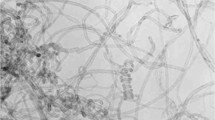Abstract
This paper reviews the relationship of the effect of different fillers used in the natural and nitrile rubber compounds on the tensile properties. The use of fillers in the rubber compounds is well known in order to modify and improve their properties. Thus, four different grades of carbon black and non-carbon black fillers were used to achieve the aim of the study. A comparison between carbon black and calcium carbonate system leads to further scientific findings for the understanding of the tensile properties of filled rubber compounds. The tensile properties of the five samples were investigated by using a Tensile Instron Machine. Five test pieces were tested for every sample at a stretching rate of 500 mm/min at standard laboratory temperature. Then, median values of the five test pieces of each sample were calculated. As the conclusion, different types of fillers results to different properties of the elastomers. Carbon black fillers can be proved to have better tensile properties compared to non-carbon black fillers. The best filler with the highest tensile properties was N220 with 23.63 MPa and elongation at break at 638.63 %.
Access this chapter
Tax calculation will be finalised at checkout
Purchases are for personal use only
Similar content being viewed by others
References
A. Mujkanovi, L. Vasiljevi, G. Ostoji, Non-black fillers for elastomers, in 13th International Research/Expert Conference Trends in the Development of Machinery and Associated Technology, (2009), pp. 865–868
A. Aruniit, J. Kers, K. Tall, Influence of filler proportion on mechanical and physical properties of particulate composite. Agron. Res. Biosyst. Eng. 5(1), 23–29 (2011)
U.K. Niyogi, Polymer Science. Delhi (2007)
M.-J. Wang, The Role of Filler Networking in Indianapolis. Indiana (1998)
M.S. Sobhy, D.E. El-Nashar, N.A. Maziad, Cure characteristics and physicomechanical properties of calcium carbonate reinforcement rubber composites. Egypt. J. Sol. 26(2), 241–257 (2003)
A. Mostafa, A. Abouel-Kasem, M.R. Bayoumi, M. G. El-Sebaie, Rubber-filler interactions and its effect in rheological and mechanical properties of filled compounds. J. Test. Eval. 38(3), 1–13 (2013)
I.S. Saad, M.S. Fayed, E. M. Abdel-Bary, Effects of carbon black content on cure characteristics, mechanical properties and swelling behaviour of 80/20 NBR/CIIR blend, in 13th International Conference on Aerospace Sciences & Aviation Technology, ASAT-13, 2009, pp. 1–9
K. Sirin, M. Balcan, F. Doğan, The influence of filler component on mechanical properties and thermal analysis of PP-LDPE and PP-LDPE/DAP ternary composites, in Polypropylene, ed. by D. Fatih (InTech, Crotia, 2012), p. 500
D.T. Norman, Rubber Grade Carbon Blacks, 13th edn. (Vanderbilt Rubber Handbook, 1990)
F. Cinaralp, L. Zullo, Reinforcing filler in the rubber industry: assessment as potential nanomaterials with a focus on tyres, European Tyre & Rubber, 2012. Available Online: www.etrma.org. Accessed 26 May 2014
J.L. Leblanc, Rubber-filler interactions and rheological properties in filled compounds, vol. 27 (2002)
BS ISO 37 Rubber, Vulcanized or Thermoplastic—Determination of Tensile Stress-Strain properties, , 2011
A. Samsuri, An Introduction to Polymer Science and Rubber Technology (Pusat Penerbitan Universiti, Universiti Teknologi MARA, Shah Alam, 2009), p. 270
K. Nagdi, Rubber as an Engineering Material: Guideline for Users (Carl Hanser Verlag, Munich, 1993)
Acknowledgments
The author would like to acknowledge that this research has been carried out as a part of RAGS project funded by Ministry of Education (MOE) and support from Research Management Institute (RMI), Universiti Teknologi Mara (UiTM).
Author information
Authors and Affiliations
Corresponding author
Editor information
Editors and Affiliations
Rights and permissions
Copyright information
© 2015 Springer Science+Business Media Singapore
About this paper
Cite this paper
Rajhan, N.H., Ismail, R., Hamid, H.A., Ibrahim, A. (2015). Influence of Different Fillers on the Tensile Properties of 50/50 NR/NBR Blend. In: Hassan, R., Yusoff, M., Alisibramulisi, A., Mohd Amin, N., Ismail, Z. (eds) InCIEC 2014. Springer, Singapore. https://doi.org/10.1007/978-981-287-290-6_66
Download citation
DOI: https://doi.org/10.1007/978-981-287-290-6_66
Published:
Publisher Name: Springer, Singapore
Print ISBN: 978-981-287-289-0
Online ISBN: 978-981-287-290-6
eBook Packages: EngineeringEngineering (R0)




